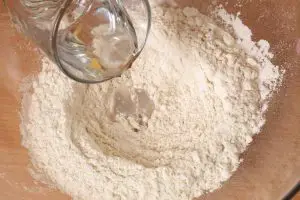Sourdough bread is perhaps one of the most popular types of bread out there and one that people enjoy making at home. When following the directions precisely, sourdough can be pretty simple to make. However, if you don’t follow the instructions, your sourdough bread may turn out a little bit too sour for your liking. Interestingly enough, sourdough actually refers to the sourdough starter as it is dough that has gone sour or fermented. This gives your bread a tangy flavor—one that may oftentimes be too much for some. If you’re looking for a way to tone down your sourdough and make it much more enjoyable, keep reading.
What Makes Sourdough Sour?
Before trying to figure out how to tone down the tanginess of your sourdough bread, it’s important to know what exactly makes sourdough sour. Sourdough’s unique flavor profile comes from lactic acid and acetic acid. Lactic acid can typically be found in yogurt, while acetic acid is found in pickled vegetables, vinegar, and certain sauces.
Although both acids can add tanginess to the bread, acetic acid is really the culprit behind your sourdough bread’s tanginess. As a result, this is what you need less of when baking your sourdough.
Tips to Make Sourdough Bread Less Sour
Now that you know why your sourdough bread may be too sour, it is time to try and make it less sour. There are several ways to do this, so one is certainly bound to work for you.
1. Avoid Whole Grain Flours
As mentioned previously, acetic acid is the reason behind your sourdough’s tanginess, which means to get it to taste milder, you need to remove some of the acetic acid. Whole grain flour actually increases the acetic acid your sourdough starter produces. Therefore, you want to be sure you are staying away from it.
2. Keep it From Producing Hooch
Hooch is the liquid that forms when your sourdough starter has run out of food. It is also what makes your sourdough taste even more sour. This means that if you prefer a mild sourdough, you want to make sure that you do everything you can to prevent hooch from forming, or you get rid of it before making your bread. Preventing hooch is as easy as feeding it with flour twice a day to stop it from getting too sour.
If you can’t prevent the hooch from forming, you can always pour it out before baking. Try to avoid mixing it into the starter or add a bit more water to it to make it milder.
3. Decrease Fermentation Time
Another way to prevent your sourdough bread from becoming too sour is to decrease the time that it ferments. There are several ways that you can do this, although the easiest tends to be to simply increase the amount of starter that you use. You can double it as well and see if this works. Other people may go as far as adding honey or sugar to their dough as this helps reduce the ferment time of your dough.
4. Reduce Your Cold Ferment
Cold ferment is used to make your bread more sour and is added in between shaping your loaf and baking it. Obviously, this means you are going to want to either skip it altogether or reduce the cold ferment. If you do decide to skip it, simply leave your sourdough to rest on the counter prior to shaping it and baking it.
5. Do Not Let Your Starter Run Out of Food
The last way to prevent your sourdough from becoming too sour is to feed your starter at least twice a day to prevent it from running out of food. Some people will even go as far as to create a feeding schedule for their sourdough starter so that they can catch it before it peaks.
Patience Is Key
When it comes to making sourdough, some people can get pretty frustrated if things don’t start going their way. However, having patience is the key to successfully baking a good sourdough loaf. For one, patience is important because you need it while your starter continues to develop and mature. Handling the dough and forming the bread can also be overwhelming, which is yet another reason patience is necessary to have.
Sourdough Needs Plenty of Oxygen
Like humans, your sourdough bread needs plenty of oxygen to flourish. This is due to the fact that the yeast and good bacteria that are present in your starter need oxygen to flourish. Without enough oxygen for your starter, it will hinder the natural process. If you want to make sure that your sourdough starter is getting enough oxygen, all you need to do is stir your starter a few times a week.
Temperature Is Vital
The sourdough process is incredibly reliant on temperature. If your starter is too cold, then it will take too long to mature. If it’s too warm, you will have to continue feeding your yeast more often than not. Be sure to find a way to manipulate the temperature to make sure that it will suit your starter.
Watch How Much Starter You Use
Obviously, without a sourdough starter, you can’t make sourdough bread. In fact, you also have to use a very specific amount of it. It’s the same with the temperature, too little of the starter and the process will take too long. Too much of it and you may end up overproofing your dough.
Conclusion
Making sourdough bread has become the favorite pastime of people over the past year when they couldn’t leave their homes. Unfortunately, some people have found that their sourdough didn’t turn out like they wanted it to. The good news is, it is rather easy to fix and just involves following directions as accurately as possible to create a sourdough bread you can be proud of.






